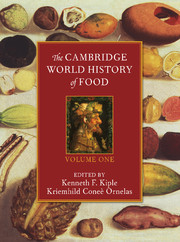Book contents
- Frontmatter
- Introduction
- Part I Determining What Our Ancestors Ate
- Part II Staple Foods: Domesticated Plants and Animals
- Part III Dietary Liquids
- III.1 Beer and Ale
- III.2 Breast Milk and Artificial Infant Feeding
- III.3 Cacao
- III.4 Coffee
- III.5 Distilled Beverages
- III.6 Kava
- III.7 Khat
- III.8 Kola Nut
- III.9 Milk and Dairy Products
- III.10 Soft Drinks
- III.11 Tea
- III.12 Water
- III.13 Wine
- Part IV The Nutrients – Deficiencies, Surfeits, and Food-Related Disorders
- References
III.1 - Beer and Ale
from Part III - Dietary Liquids
Published online by Cambridge University Press: 28 March 2008
- Frontmatter
- Introduction
- Part I Determining What Our Ancestors Ate
- Part II Staple Foods: Domesticated Plants and Animals
- Part III Dietary Liquids
- III.1 Beer and Ale
- III.2 Breast Milk and Artificial Infant Feeding
- III.3 Cacao
- III.4 Coffee
- III.5 Distilled Beverages
- III.6 Kava
- III.7 Khat
- III.8 Kola Nut
- III.9 Milk and Dairy Products
- III.10 Soft Drinks
- III.11 Tea
- III.12 Water
- III.13 Wine
- Part IV The Nutrients – Deficiencies, Surfeits, and Food-Related Disorders
- References
Summary
Beer and ale are mildly alcoholic beverages made from the action of yeast fermenting a usually grain-based mixture. Throughout their history, they have constituted both a refreshing social drink and an important energy-rich food. The basic ingredients of most beers and ales have included grain, water, yeast, and (more recently) hops, and despite many regional variations, the process of fermenting the grain has changed little over time. To be completely accurate, it must be noted that ale is defined as unhopped beer; in this chapter, however, the terms “beer” and “ale” are employed interchangeably for the period before hops were used.
The Chemical Basis of Fermentation
Before fermentation can take place, yeast, a single-cell fungus occurring naturally in several varieties, must be allowed to act on the sugar present in grain. This releases two crucial by-products, alcohol and carbon dioxide. A grain often used for this purpose is barley – even though, in its natural state, it contains only a trace amount of free sugar – because of its high content of starch, a complex polymer of sugar. Barley also contains substances known collectively as diastases, which convert the barley starches into sugar to be used as food for the growing plant. When barley is crushed and dried carefully, the essential starches and diastases are released and preserved, rendering a substance called “malt.”
Until sometime around the ninth century, “beer” was actually “ale,” made by a process known as mashing, whereby the barley malt was mixed with hot – but not boiling – water. The effect of the hot water was to induce the diastases to act immediately in breaking down the complex starches into sugar. This process is referred to as conversion and results in “wort,” one of its most essential products. The mashing procedure not only produced the brown, sugary wort but also permitted inert elements of the barley, such as the husks, to be drawn off. In the production of pure ale (such as the first human brewers would have made), all that remained was for yeast to act upon the wort so that the sugars could be converted into alcohol and carbon dioxide.
- Type
- Chapter
- Information
- The Cambridge World History of Food , pp. 619 - 625Publisher: Cambridge University PressPrint publication year: 2000
References
- 4
- Cited by

